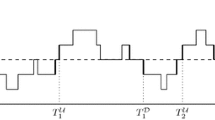Abstract
We use the concept of burstiness to propose new descriptors of arrival processes or, more generally, point or traffic processes. We say that the arrival process is in aburst when its interarrival times are less than or equal to some threshold value; during periods in which interarrival times are greater than the threshold value, the process is in agap. We propose to describe the arrival process in terms of the number of arrivals during a burst (gap) and the duration of a burst (gap). For the case of discrete-time Markovian arrival processes we derive the distribution of the number of arrivals during a burst (gap) and the mean duration of a burst (gap). We present numerical results to illustrate how our descriptors can be used to understand the behavior of an arrival process and the congestion it induces in a queueing system. We also report the results of an experiment which shows a statistical relationship between two of our descriptors and a measure of queueing congestion.
Similar content being viewed by others
References
A.S. Alfa and M.F. Neuts, Modelling vehicular traffic using the discrete time Markovian arrival process,Transportation Science 29(2) (1995) 109–117.
U.N. Bhat,Elements of Applied Stochastic Processes (Wiley, New York, first edition, 1972).
G.H. Golub and C.F. Van Loan,Matrix Computations, fourth printing (1985), (Johns Hopkins Univ. Press, Baltimore, MD, 1983).
R. Gusella, Characterizing the variability of arrival processes with indexes of dispersion,IEEE Journal on Selected Areas in Communications 9(2) (1991) 203–211.
H. Heffes and D.M. Lucantoni, A Markov modulated characterization of packetized voice and data traffic and related statistical multiplexer performance,IEEE Journal on Selected Areas in Communications SAC-4(6) (1986) 856–867.
H. Heffes, A class of data traffic processes — covariance function characterization and related queueing results,The Bell System Technical Journal 59(6) (1980) 897–929.
D.P. Heyman and M.J. Sobel,Stochastic Models in Operations Research, Vol. I (McGraw-Hill, New York, 1882).
M.A. Johnson, D. Liu and S. Narayana, Burstiness descriptors for Markov renewal processes and Markovian arrival processes, to appear inStochastic Models.
D. Liu and M.F. Neuts, Assessing the effects of bursts of arrivals on the characteristics of a queue, in:Proceedings of IMSIBAC 4 (San Sebstian, Spain, August, 1992).
D. Liu and M.F. Neuts, A queueing model for an ATM rate control scheme,Telecommunication Systems 2 (1994) 321–348.
B. Melamed, TES: A class of methods for generating autocorrelated uniform variates,ORSA Journal on Computing 3(4) (1991) 317–329.
M.F. Neuts,Matrix-Geometric Solutions in Stochastic Models (Johns Hopkins Univ. Press, Baltimore, MD, 1981).
M.F. Neuts, The caudal characteristic curve of queues,Advances in Applied Probability 18 (1986) 221–254.
M.F. Neuts, The burstiness of point processes,Stochastic Models 9(3) (1993) 445–466.
M.F. Neuts, D. Liu and S. Narayana, Local Poissonification of the Markovian arrival process,Stochastic Models 8(1) (1992) 87–129.
A. Ravindran, D.T. Phillips and J.J. Solberg,Operations Research: Principles and Practice (Wiley, New York, second edition, 1987).
B.E. Patuwo, D.C. McNickle and R.L. Disney, The effect of correlated arrivals on queues,IIE Transactions 25(3) (1993) 105–110.
K. Sriram and W. Whitt, Characterizing superposition arrival processes in packet multiplexers for voice and data,IEEE Journal on Selected Areas in Communications SAC-4(6) (1986) 833–846.
Author information
Authors and Affiliations
Rights and permissions
About this article
Cite this article
Johnson, M.A., Narayana, S. Descriptors of arrival-process burstiness with application to the discrete Markovian arrival process. Queueing Syst 23, 107–130 (1996). https://doi.org/10.1007/BF01206553
Received:
Revised:
Issue Date:
DOI: https://doi.org/10.1007/BF01206553




